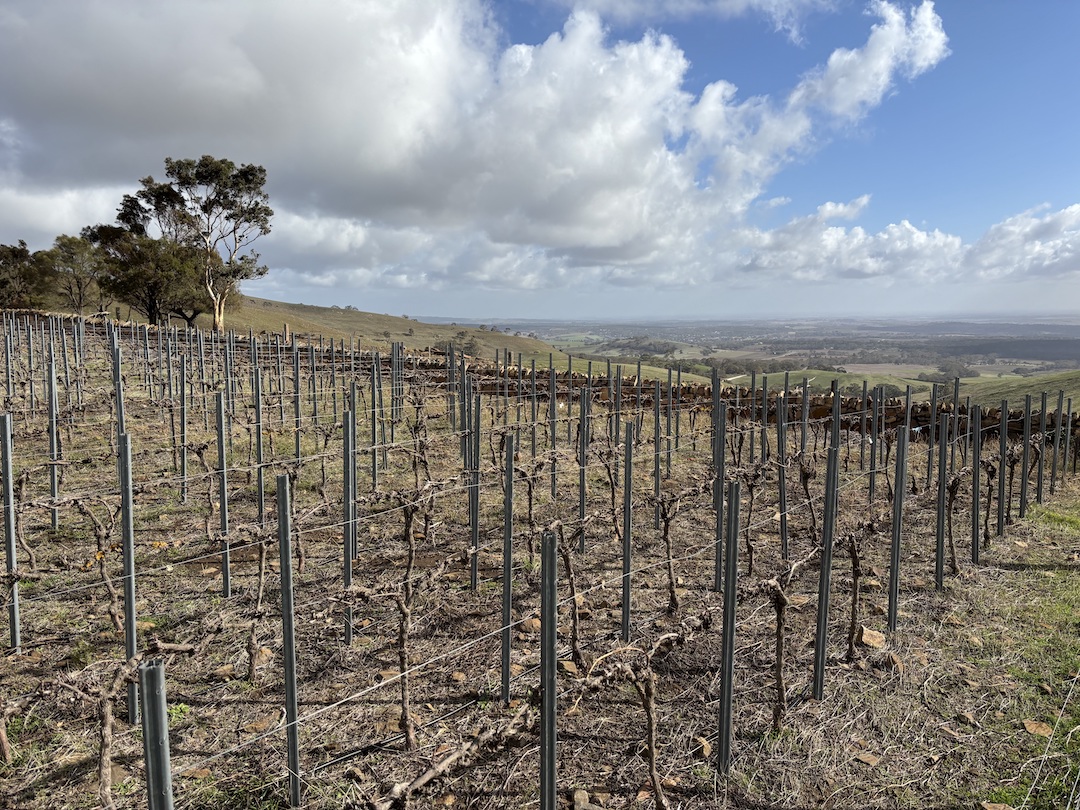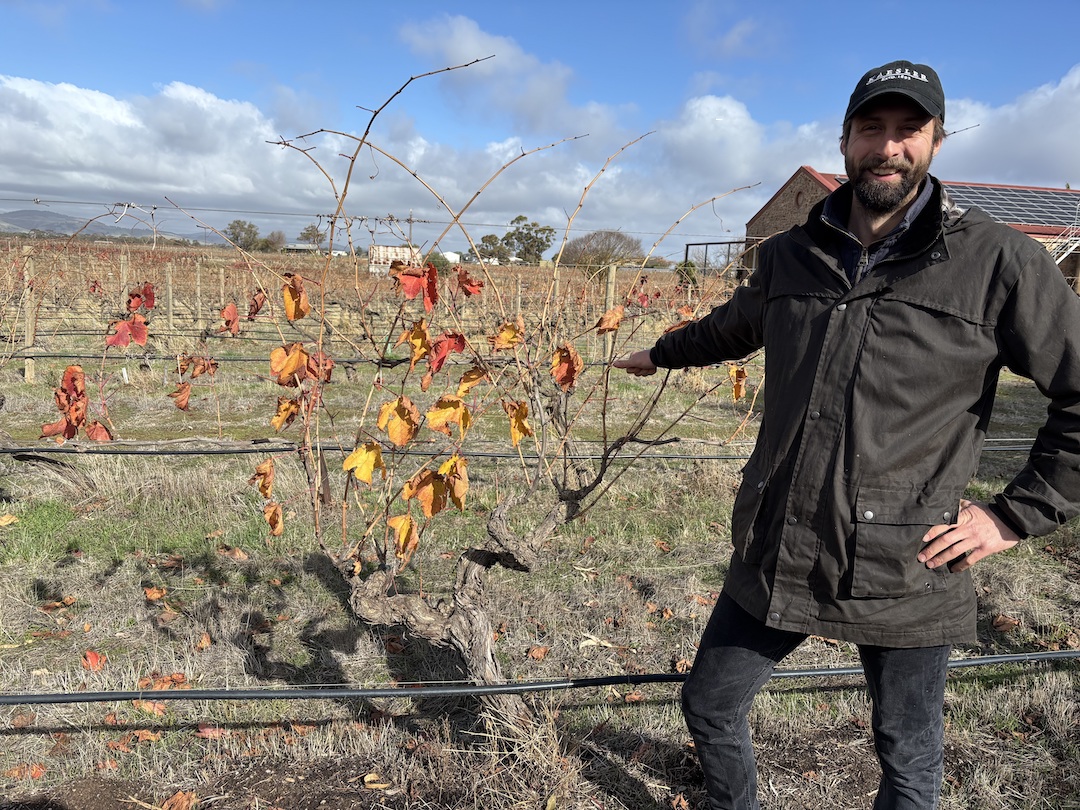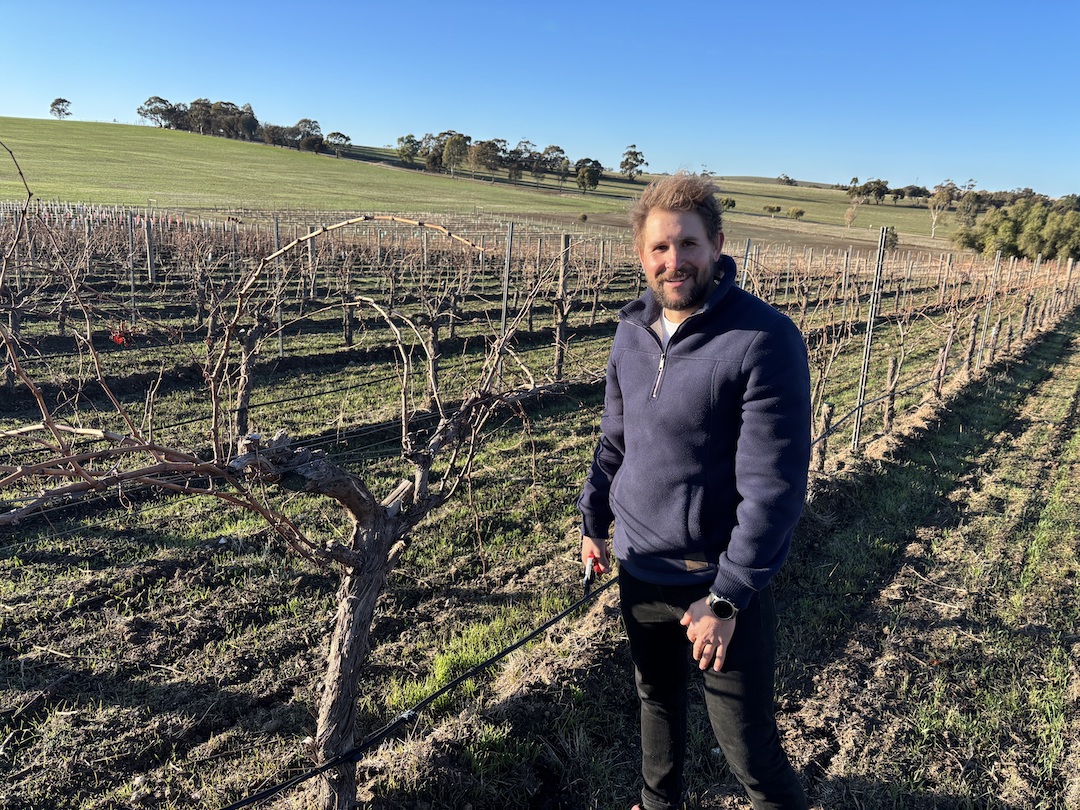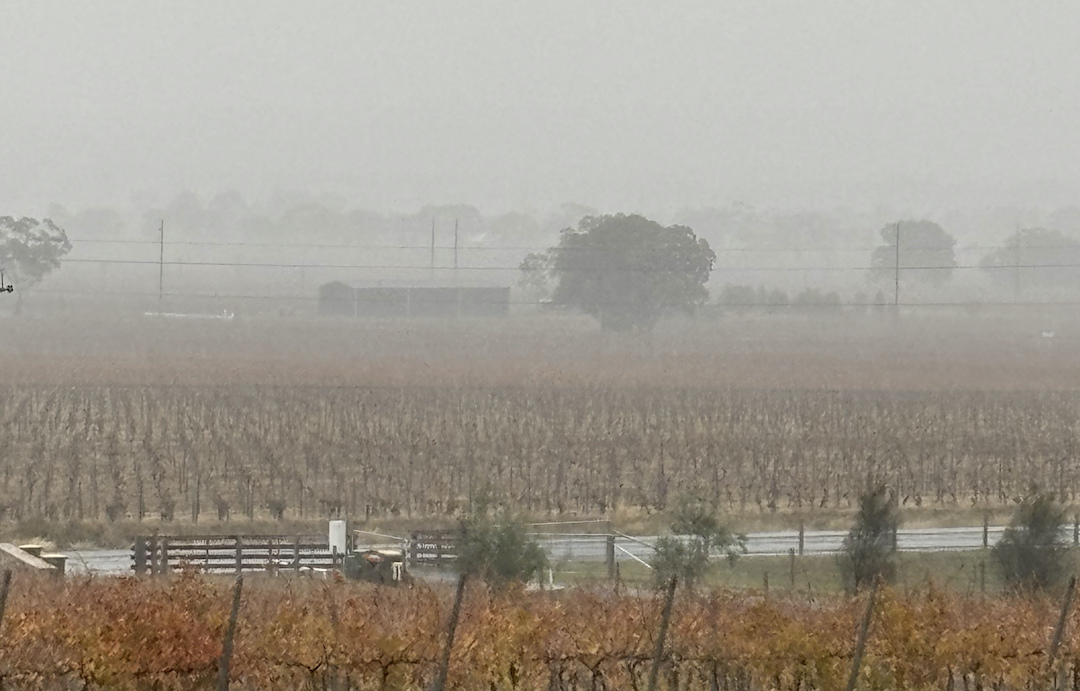Browse using the new Vinous website now. Launch →
Printed by, and for the sole use of . All rights reserved © 2015 Vinous Media
Barossa and Clare Valley: The Champion and the Contender
BY ANGUS HUGHSON | AUGUST 12, 2025
Travelling north from Adelaide in mid-June 2025, the barren plains were surprisingly green. In the months beforehand, Sydney had been hit by over 500 millimeters of rain in autumn alone, while South Australia had only just received its first meaningful rainfall of 2025. Tanunda, at the heart of the Barossa, had seen just 50 millimeters by May, although since June, significant rain events have replenished soil moisture levels. Recent seasons have presented their fair share of challenges, so it was with some trepidation that I set out to taste these wines. Those initial, surprising glimpses of green, after the driest spell on record and in stark contrast to conditions where I call home on the country’s east coast, were a reminder that Australia is not a place of temperate and even conditions. It is wild and untamed, yet resilient, traits that present significant challenges but are also a vital part of the nation’s wine landscape.
North of Adelaide lie two key regions: Barossa and Clare Valley, both of which I visited for this report. Barossa, with global superstars such as Henschke and Penfolds, attracts constant attention. More than 13,000 hectares are planted there, with a steady stream of local and international visitors to the region’s well-appointed cellar doors. Broad swathes of lower-elevation vineyards are complemented by higher-elevation, lower-yielding sites in the Eden Valley, all offering a reliable source for quality wine. In great vintages, this viticultural paradise produces ripe, approachable and flavoursome wines, the best of which can age quite well.
Recent vintages have seen some changes in the Barossa. This is in part a stylistic evolution as new ideas have taken hold thanks to a younger generation of winemakers striving to make their mark, as well as a rationalization due to the unpredictable manner of exports to China, formerly a pot of gold for Barossan producers. Cooler years have required thoughtful winemaking and greater agility from winemakers to make the best of these unusual seasons, particularly 2023. Despite significant climate challenges, I was pleased to see that some impressive wines emerged in 2023 from winemakers who adapted best to the conditions. Better still, these wines help to remind the wine-drinking public that the Barossa is not a one-trick pony. The region does not need to rely on hot, dry seasons to craft stylish wines.
Further north and to the west, Clare Valley offers a very different terroir proposition. I have been remiss in not writing about Clare Valley more comprehensively until now, as the region possesses a fascinating and complex terroir and regularly crafts some of the country’s leading wines. While Barossa is the favourite child—confident and composed—Clare is the quiet achiever, working away in the background to earn the recognition it deserves. There are no easy wins for Clare Valley on the international stage, which drives the best local winemakers to push the envelope. With a handful of talented producers leading the way, Clare Valley has the potential to raise its profile and gain a greater foothold in the fine wine market over the coming years.

The iconic Steingarten Vineyard, looking down over the Barossa Valley.
The Clare Valley encompasses a string of quaint little towns, full of old worker cottages with stone walls hewn from the local hillsides, thick enough to keep the heat in during the depths of winter while remaining cool in the summer. There is a charming and slightly reserved small-town feel here, and the wines are generous and honest. A gentle rivalry exists between Clare Valley and Barossa. Bragging rights are currently in Barossa’s favour, but a healthy combination of historic wineries and rising stars in Clare are putting that to the test.
The basic topography here is relatively simple thanks to a number of north-south valleys with low mountain ranges on both sides, plus lower elevations and warmer zones at its southern and northern extremities. The broader region ranges in elevations from 200 to 600 meters, although the majority of vineyards are located at elevations 400-500 meters. The total vineyard area is a healthy 5,100 hectares, arranged in a roughly rectangular shape. More broadly, Clare Valley sits on the western edge of the Mount Loftyranges, where cooler and warmer influences meet to create unsettled conditions. Frost and hail can be an issue and have regularly impacted recent vintages. Clare Valley’s location, further inland than Barossa, also provides a more continental climate—while daytime summer temperatures regularly exceed 30°C, nights drop to an average of 13°C. This strong diurnal shift is a vital factor in the local wine style and quality, lending a savoury edge to red wines. Since the summers can get baking hot and dry, eastern-facing slopes are particularly advantageous for the production of fine Riesling.
Geology plays a defining role in Clare Valley, potentially more so than for the vast majority of Australia’s wine regions. Five hundred million years ago Clare was located just off the Australian coast, which saw layers of maritime sediments (silt, sands and carbonates) deposited. These built up over time and were compacted under pressure, creating siltstone, sandstone and limestone that were later uplifted and exposed. The result is 11 different soil types that exist across the region’s five districts (Auburn, Clare, Polish Hill River, Sevenhill and Watervale). The soils are highly complex, varying from broken slate and shale in Polish Hill River, to red terra rossa over limestone at Watervale and Auburn, to clays and sandy loams. These clays and loams are useful in dry vintages for their water-holding capacity, while shale and limestone elements are particularly helpful in creating stylish Riesling. Clare Valley is a curious and multifaceted region, where cool, elevated sites can deliver scintillating whites, while warmer, lower sites give rise to muscular, brooding red wines, more savoury than fruit-driven and quite different from their more famous brethren in Barossa. Rarely brash or overstated, Clare Valley wines often demonstrate remarkable sophistication and longevity.
Battle of the Titans
It may come as a surprise to readers that parts of Clare Valley and the wider Barossa district are highly fancied for dry Riesling, sourced from warm zones where elevation and continental conditions bring rapid evening cooling. Riesling has a long history among inland regions, thanks in part to the arrival of a large number of German immigrants in the mid-19th century. Within Clare and Eden Valleys, Riesling is without doubt the leading white variety, both in terms of plantings and quality. Riesling has been a particularly strong performer in recent years, due to the run of cool vintages across Barossa and Clare Valley from 2021 to 2024.

Chief Winemaker Tim Dolan in Kaesler’s Old Bastard Vineyard, planted in 1893.
Identifying a definitive feature that differentiates these two regions is not always easy. The Rieslings from Eden Valley are generally more fine-boned, streamlined and elegant, pictures of restraint rather than overt power. The best examples from Clare Valley display inherent power, firm acidity and excellent definition. While vintages often favor one region over the other, preference is generally more a matter of individual taste rather than one having a long-term edge over the other. Both can craft stunning and ageworthy wines.
Metronomic winemaking has been a historic feature of the style in both Clare and Eden Valleys. Pristine fruit is picked early to retain acidity and cool-fermented in stainless steel, with every measure taken in the winery to preserve purity and freshness. Alcohols of 11-12% are not uncommon, helping to foreground Riesling’s finely sculpted features. Winemaking rules were traditionally firm and produced a broad range of similar, squeaky-clean wines, terroir alone being the key differentiator. While many are most enjoyable in the flourish of youth, the finest Rieslings begin as shy, tightly bound, understated wines before building into breathtaking beauties that are at their best after a decade or more in bottle. The appearance of the Mosel’s Ernie Loosen on the scene, in his collaboration with the Barry family from Clare, is an indicator of the quality and aspirations afoot in this part of Australia.
The last decade, however, has seen a subtle stylistic shift, with a number of winemakers placing increased focus on crafting wines with more texture and immediate complexity. Some are shedding their strict winemaking regimes and branching out into new methods, while others are holding their wines back in bottle and bringing them to market much closer to their peak. This is to be applauded, as it is hopefully the beginning of a new chapter in the story of Australian Riesling.
The Barry family has a foot in both the old and new camps, preferring traditional winemaking for their exceptional Florita and Spring Farm range. For the Wolta Wolta collaboration with Ernie Loosen, the Barrys utilise wild fermentation in a 3,000-litre barrel before the wine is aged on gross lees for two years. Winemakers like Jono Koerner are conducting fermentations in amphora to tighten up textures. Yalumba’s 1961 Pewsey Vale Eden Valley Riesling benefits from additional detail brought about by a wild ferment and a few months of lees-aging. Other winemakers such as Kerri Thompson and Andrew Kenny prefer to use neutral yeasts for ferments and age on fluffy lees only. These wines, bottled under the Wines by KT, Skillogalee and Kenny Wine labels, are some of the most enthralling examples of the modern Clare Valley style. Taken together, these winemakers illustrate how regional styles and winemaking are being reimagined with some outstanding results.
The Rieslingfreak wines made by John and Belinda Hughes lie at the other end of the stylistic spectrum. Immaculate vineyards and viticulture, along with immense attention to detail at every stage of the grape-growing and winemaking process, are core concepts. In a short period of time this approach has seen these wines rise to the highest echelon of Australian Riesling. Going against tradition, Rieslingfreak does not press at all, instead using only free-run juice collected after gently spinning the fruit in a bag press. This extracts fewer phenolics than typical pressing would, even less than in Champagne. The duo also employ novel yeasts that mop up oxygen, thereby reducing dissolved oxygen to negligible levels and, in turn, preserving fruit freshness. For readers seeking wines of purity, the Rieslingfreak bottlings certainly deliver in their youth and will continue to do so with bottle age. This is a genuinely exciting time for South Australian Riesling as local styles evolve.

Winter pruning at the Kenny Wine home vineyard outside the small town of Auburn.
Surprising Diversity
On the surface, there is little climatic difference between Barossa and Clare Valley. Mean January temperatures hover around 22°C in both, with daily ranges of 14–31 °C and similar rainfall. The cooling advantage of higher-elevation vineyards in Clare is offset by the inland, more continental climate. But numbers never tell the whole story. Travel through the regions and you’ll find distinctly different feels: the open, rolling low hills of Barossa Valley contrast the narrow, twisting valleys in Clare. Aspect is less important in much of Barossa, whereas in Clare, it can be key. These factors give Clare much broader climatic variation than in the more consistent Barossa Valley floor, for which simple regional averages do not account. Between Polish Hill River and Sevenhill, mid-summer daily averages can differ by 2°C, which has an enormous impact. This immense and sometimes contradictory diversity has historically been part of Clare Valley’s problem.
Clare is full of various little pockets that have their own microclimates, each suitable to different grape varieties, while Barossa is more homogeneous. In this year’s tastings, the picture is much more intriguing for red wines than whites. Barossa retains its classic strength with a wide range of Shiraz expressions, while Grenache and occasionally Cabernet Sauvignon can also shine in the right vintages on the right soil types. Soils seem to be particularly important for Grenache, with sandy soils (particularly around Vine Vale) capable of turning out truly exceptional wines.
Clare’s wide variability of microclimates and complex soil types offers a richer tapestry of options, with a wider array of red varieties that are strong across the board. Of note, the average alcohol level for the wines I tasted for this report was sub-14%, illustrating a shift towards mid-weight styles. Of course, Shiraz remains a staple, making up 55% of red variety plantings in Clare. Historically, there has been a tendency for some Clare wineries to pursue the typically robust South Australian style. These wines can be quite successful, as seen in Jim Barry’s The Armagh and the Kilikanoon Oracle Shiraz. However, in this tasting, many interpretations of the variety impressed with their mix of elegance and understated power. In a wine world moving away from blockbuster reds, Clare Valley clearly has an opportunity to fill a niche.
Even more interesting is what can be achieved with Bordeaux varieties. Clare has a significant history with Cabernet Sauvignon and the unusual blend of Cabernet Sauvignon with Malbec, which arose from the historic Wendouree’s iconic wines (from plantings dating back to 1893). There is an unexpected presence to the seamless, unforced and stylish expressions of Cabernet Sauvignon from Clare Valley’s cooler sites. New World purity meets Old World elegance and definition in these wines. Many of these wines are not highly expressive at the jump but have the backbone to develop over time.
Still, Cabernet Sauvignon here can be incredibly statuesque, particularly when blended with Malbec, as illustrated by the 2022 Jim Barry Clarevale. Malbec has found a surprising and happy home in Clare, though there are only a minuscule 90 hectares planted, as the local terroir seems to draw out the variety’s gravelly minerality. As with all the greatest classic Clare blends, the vibrant, sweet fruit of Clare Cabernet Sauvignon, with its deep wells of tannin, beautifully offsets Malbec’s natural generosity to deliver classically styled wines that are well constructed for long aging. In the 2022 vintage, the Clarevale Cabernet Malbec trumps its more famous sibling, The Armagh, demonstrating a staggering level of quality while illustration Clare Valley’s potential future trajectory towards deeply flavoured, stylish, structured Cabernet Sauvignon. With wines such as these, there is a strong sense that Clare Valley has what it takes to more consistently rival the best from Barossa. Only time will tell if that will come to fruition.

Much-needed soaking rains finally fell in the Barossa in late June.
Rollercoaster Vintages
The vast majority of wines in this year’s report are from the 2022-2025 vintages, during which time Barossa and Clare Valley have experienced an extreme variety of conditions. The distance between the two regions is just 110 kilometers, so there are strong similarities between vintages (with some caveats). It is difficult to draw any broad conclusions as of yet on 2025, but it is worth noting that this was a hot and dry season. The key early challenge was that a lack of winter and spring rains left the regions susceptible to frost, which hit large areas of both Barossa and Clare Valley in early September. Temperatures fell to -4°C in some parts of the Barossa Valley. The very early seasonal timing saw some affected vineyards come back to life with fertile secondary shoots, while the warm and dry conditions that followed allowed the resulting fruit to reach full ripeness. For vineyards that avoided the frost, 2025 looks like a strong year with full-flavoured wines, which have not been seen for some time.
Two thousand twenty-four was the vintage where the weather in Barossa and Clare Valley turned the corner and started to resume normal programming, with a warmer and particularly dry end to the growing season thanks to the emergence of El Niño in winter 2023. However, it was not without its challenges. A dry and warm winter and spring brought on early growth, which unfortunately met a devastating late October frost in lower-lying areas of Clare, Eden Valley and Northern Barossa. This diminished some yields by up to 50%. Eden Valley and Clare Valley were also hit by hail. Early summer rain in both regions replenished groundwater, but a very dry summer and autumn followed. For vineyards that were unscathed, a warmer-than-average February, a March heatwave in Barossa and barely any rain combined to generate small, flavoursome berries and powerful wines with very promising early releases. A late February heatwave in Clare Valley similarly yielded deeply flavoured red wines. Rieslings from both regions are exceptional, although the jury is still out on whether 2024 will be a truly outstanding vintage for reds.
The 2023 vintage was one of the more challenging in recent years, particularly for red wines in Clare and Barossa Valleys. It began with torrential rain in winter and spring that led to a late budburst. While there was some risk of disease, growers were well prepared. Large canopies and sizable potential yields were a good early sign, with average temperatures in Barossa during the growing season and an absence of hot spells. Markedly cooler temperatures in Clare Valley slowed ripening, with weather in both regions highly favourable for Riesling. Barossa Shiraz harvests began in March, with the wines showing more supple, red-fruited characteristics than usual. Rain in April dragged out harvest for some later-ripening varieties into May, the latest finish to a vintage in recent memory. In Clare, April rain hit before the red wine harvest, bringing disease pressure and making full ripening difficult for vineyards with heavy crop loads. Overall, red wines from 2023 will be earlier maturing than any recent vintages.
I covered the strong 2022 Barossa vintage in detail here. For Clare Valley, the season started with good winter and spring rains, setting the season up well with excellent fruit set after a delayed budburst. A cool and drier-than-average growing season then followed, with strong yields and favourable autumn weather allowing winemakers to pick at their leisure. The cooler conditions certainly favoured Riesling and Cabernet Sauvignon over Shiraz.
I tasted the vast majority of these wines in Barossa and Clare Valley in June 2025, with the remainder in Sydney soon thereafter.
© 2025, Vinous. No portion of this article may be copied, shared or redistributed without prior consent from Vinous. Doing so is not only a violation of our copyright but also threatens the survival of independent wine criticism.
You Might Also Enjoy
The Second Coming of Australian Chardonnay, Angus Hughson, June 2025
McLaren Vale: Pushing the Envelope of Refinement, Angus Hughson, April 2025
Behind the Red Curtain: Penfolds Special Bins from the Vault, Angus Hughson, March 2025
Barossa 2022: Run, Don’t Walk, Angus Hughshon, August 2024
Show all the wines (sorted by score)
- Adelina
- Alkina
- Arila Gardens
- Atlas Wines
- Atze's Corner Wines
- Bosward Wines
- Camino Wine Co
- Chaffey Bros. Wine Co
- Chateau Tanunda
- Cimicky Wines
- Cirillo Estate Wines
- Claymore Wines
- Corryton Burge
- Crabtree
- Eden Hall
- Eisenstone
- Elderton
- First Drop Wines
- Gatt Wines
- Gertie Wines
- Gibson Wines
- Glaetzer Wines
- Grant Burge Wines
- Greenock Creek
- Grosset Wines
- Gullyview Estate
- Handpicked Wines
- Hare's Chase
- Hayes Family Wines
- Head Wines
- Heggies Vineyard
- Henschke
- Hentley Farm
- Hewitson
- Hill River Wines
- Hoffmann Family Vineyards
- Hutton Vale
- Irvine Wines
- Jacob's Creek
- Jim Barry Wines
- John Duval Wines
- Kaesler Wines
- Kalleske
- Kenny Wine
- Kilikanoon
- Kirrihill Wines
- Knappstein
- Lambert Estate
- Langmeil Winery
- Levrier Wines by Jo Irvine
- Lou Miranda Estate
- Love Over Gold Barr Eden Estate
- Matriarch and Rogue Wines
- Miss Zilm
- Mitchell Wines
- Mount Horrocks Wines
- O'Leary Walker Wines
- Orlando
- Pauletts
- Penfolds
- Peter Lehmann Wines
- Pewsey Vale Vineyard
- Pikes
- Rieslingfreak
- Schild Estate
- Schubert Estate
- Schwarz Wine Co
- Seabrook Wines
- Seppeltsfield
- Sevenhill Cellars
- Skillogalee
- Small Victories Wine Co
- Sons of Eden
- Stage Door Wine Co
- St Hallett
- St Hugo
- Sussex Squire
- Tait Wines
- Tarrawatta Wines
- Taylors
- Teusner
- The Usual Suspects Wine Collective
- Thistledown Wines
- Tim Adams Wines
- Tim Smith Wines
- TOPÉ Wines
- Torbreck Vintners
- Two Hands Wines
- Watervale Gardeners
- Whistler Wines
- Wines by KT
- Yalumba
- Yelland & Papps
- Z Wine
